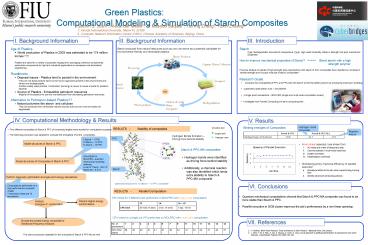I' Background Information - PowerPoint PPT Presentation
1 / 1
Title:
I' Background Information
Description:
Plastics are used for a variety of purposes ranging from ... Reaction Adduct. Hydrogen bond composite. Starch & PPC-MA composites. 1P. 1A. 1A 1P. CPU time ... – PowerPoint PPT presentation
Number of Views:74
Avg rating:3.0/5.0
Title: I' Background Information
1
Green Plastics
Computational Modeling Simulation of Starch
Composites
Sachin S. Joshi1, Alexander Mebel1, S. Masoud
Sadjadi1, Yuming Zhang2, Yuxin Zhuang21. Florida
International University, Miami FL 33199 2.
Computer Network Information Center (CNIC),
Chinese Academy of Sciences, Beijing, China
I. Background Information
II. Background Information
III. Introduction
- Age of Plastics
- World production of Plastics in 2003 was
estimated to be 174 million tonnes a !!! - Plastics are used for a variety of purposes
ranging from packaging, electrical components,
automotive components to high tech industrial
applications in aerospace and biomedical
engineering. - Roadblocks
- Disposal Issues - Plastics tend to persist in
the environment. - They are not easily broken down by the
micro-organisms present in the environment and
hence non-biodegradable. - Another widely used practice Incineration
(burning) is known to cause al sorts for
pollution hazards. - Source of Plastics - Exhaustible petroleum
resources - Majority of the plastics we use are manufactured
from decreasing petroleum resources. - Alternative to Petroleum-based Plastics??
- Natural polymers like starch and cellulose
- They are produced from renewable natural sources
such as corn and are easily bio- degradable.
Starch Pros Biodegradable, Abundant
Inexpensive. Cons High water Solubility, Weak in
strength and poor mechanical properties How to
improve mechanical properties of Starch? gtgtgtgtgt
Blend starch with a high strength
polymer Previous studies on blends of high
strength poly-caprolactone with starch to form
composites have reported an increase in tensile
strength and Youngs modulus of starch composites
b
Starch produced from natural resources such as
corn can serve as a potential candidate for
environmental friendly and renewable plastics
Plastic Products
Organic Waste Collection
Processing
Research Goals
Compost
- Compare the compatibility of PPC and PPC-MA
with starch to find the better polymer by
employing molecular modeling. - 3 geometry optimization runs GAUSSIAN
- 3 single point calculations MOLPRO (single and
multi-node computation levels) - Investigate how Parallel Computing will save
computing time .
Starch Source
Sun
Biodegradation
Carbon di-oxide WaterInorganics
Photosynthesis
IV. Computational Methodology Results
V. Results
- Five different composites of Starch PPC of
increasing lengths were studied for computation
purposes. - The following procedure was adopted to compute
the energetics of all the composites.
Binding energies of Composites
Hydrogen bond composite
Carbon atom
RESULTS - Stability of composites
Reaction Adduct
Oxygen atom
Hydrogen Bonds formation Driving force behind
stability
Hydrogen atom
PPC
1 Starch 1 PPC 10 Starch 10 PPC 15 starch
15 PPC
Model structures of Starch PPC
2.42 Ao
- A non-linear speedup. loss arises from
- I/O reads and writes of temporary data
- Communications in multi-node machines
- System overhead
- Parallelization overhead
- Scheduling policy improves efficiency of parallel
execution - Allocate priorities to the job which expects long
running time - Identify advanced scheduling policies
Starch PPC-MA composites
GAUSSIAN MOLPRO quantum mechanical modeling
software Level of Theory B3LYP Basis set
6-31G
- Hydrogen bonds were identified
- as driving force behind stability
- Additionally, a chemical reaction
- was also identified which lends
- extra stability to Starch
- PPC-MA composite
2.93 Ao
Model structures of Composites of Starch PPC
Starch
Perform Geometry optimization single point
energy calculations
Optimized structure for 10 Starch 10 PPC
composite
VI. Conclusions
Computations performed on a high performance
computer cluster7 execution hosts and 14
processors.
RESULTS - Parallel Computation
CPU times for 3 different jobs performed on
MOLPRO with single-node computation
- Quantum mechanical computations showed that
Starch PPC-MA composite was found to be - more stable than Starch PPC.
- Parallel execution in GCB cluster improves the
jobs performance by a non-linear speedup.
Analyze Energies of conformation
Discard Higher energy conformations
CPU times for a single job (1P) performed on
MOLPRO with multi-node computation
VII. References
Choose the lowest energy composite for
Vibrational Frequency Analysis
The above procedure repeated for the composite of
Starch PPC-Ma as well
- J. Feldman. BASF News Release. Trade Conference K
2004. Plastics Materials of the 21st Century - L. Chen, Y. Ni, X. Bian, X. Qui, X. Zhuang, X.
Chen, X. Jing. A novel approach to grafting
polymerization of caprolactone onto starch - Granules. Carbohydrate Polymers 60 (2005)
103-109.































